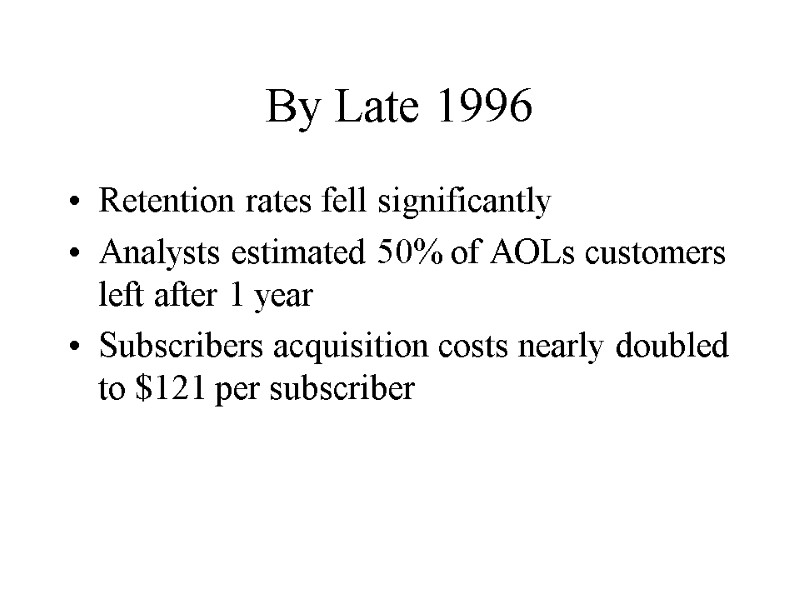Case Study: AOL Lecture 2: Business Analysis Questions


Case Study: AOL Lecture 2: Business Analysis

Questions 1. Prior to 1995, why was AOL so successful in the commercial online industry relative to its competitors CompuServe and Prodigy? 2. As of 1995, what are the key changes taking place in the commercial online industry? How are they likely to affect AOL's future prospects?

Prior to 1995 At the time of the case, AOL was the dominant player in the commercial online services industry with bigger market share than its two main rivals—Prodigy and CompuServe. AOL had a subscriber base of close to 4 million people.

Reasons for Success Easy to use interface Successful marketing Relationship with high quality providers

All Mutually reinforcing

Recoup Investment in Marketing? Yes, with a high degree of certainty Why: AOL had the most user-friendly interface for accessing online services and the Internet, customers who signed up with AOL did not have a reason to switch = subscriber retention rates were high. powerful intermediary between a large subscriber base and high quality content providers, significant bargaining power = increasing its profitability. chat rooms, very popular part of AOL's service offering, benefited from the large subscriber base.

What were the key changes taking place? Microsoft decided to enter the industry with its Microsoft Network (MSN) vast installed base of operating systems = natural advantage in gaining market share quickly Given the considerable financial resources available to Microsoft, MSN could be a source of formidable competition to AOL.

What were the key changes taking place Potential Competition emerged: Netscape Easy to use web browser Free access to internet + world-wide-web AOL charged a free = considerable threat E-mail providers entered the market e.g. AT&T, MCI

Changes in Competitive Landscape AOL’s power over: Subscribers Content providers Decreased dramatically Content providers Increased alternatives Mover from AOL or Demand higher fees Subscribers: fees and retention rates likely to decrease

Competitive Advantage? Potentially stay longer Medium for chat

Business Risk? Due to rapid growth Unable to manage operations to meet demand? Need significant investment in telecommunications equipment and computer hardware/software Failure of this and increased competition Major blow to future prospects

Subsequent developments Forced to offer flat rate fee $19.95 per month Resulted in: Dramatic increase in user connection time Major operational problems Subscribers frustrated: inability to access

By Late 1996 Retention rates fell significantly Analysts estimated 50% of AOLs customers left after 1 year Subscribers acquisition costs nearly doubled to $121 per subscriber
8582-case_study-aol.ppt
- Количество слайдов: 13

